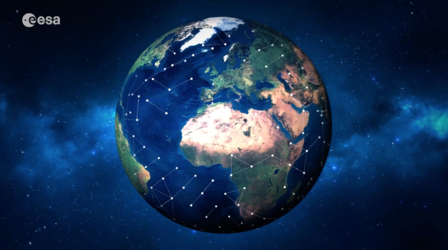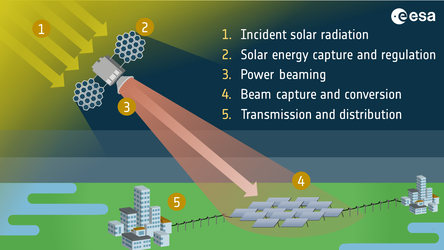Accept all cookies Accept only essential cookies See our Cookie Notice

About ESA
The European Space Agency (ESA) is Europe’s gateway to space. Its mission is to shape the development of Europe’s space capability and ensure that investment in space continues to deliver benefits to the citizens of Europe and the world.
Highlights
ESA - United space in Europe
This is ESA ESA facts Member States & Cooperating States Funding Director General Top management For Member State Delegations European vision European Space Policy ESA & EU Space Councils Responsibility & Sustainability Annual Report Calendar of meetings Corporate newsEstablishments & sites
ESA Headquarters ESA ESTEC ESA ESOC ESA ESRIN ESA EAC ESA ESAC Europe's Spaceport ESA ESEC ESA ECSAT Brussels Office Washington OfficeWorking with ESA
Business with ESA ESA Commercialisation Gateway Law at ESA Careers Cyber resilience at ESA IT at ESA Newsroom Partnerships Merchandising Licence Education Open Space Innovation Platform Integrity and Reporting Administrative Tribunal Health and SafetyMore about ESA
History ESA Historical Archives Exhibitions Publications Art & Culture ESA Merchandise Kids Diversity ESA Brand Centre ESA ChampionsLatest
Space in Member States
Find out more about space activities in our 23 Member States, and understand how ESA works together with their national agencies, institutions and organisations.
Science & Exploration
Exploring our Solar System and unlocking the secrets of the Universe
Go to topicAstronauts
Missions
Juice Euclid Webb Solar Orbiter BepiColombo Gaia ExoMars Cheops Exoplanet missions More missionsActivities
International Space Station Orion service module Gateway Concordia Caves & Pangaea BenefitsLatest
Space Safety
Protecting life and infrastructure on Earth and in orbit
Go to topicAsteroids
Asteroids and Planetary Defence Asteroid danger explained Flyeye telescope: asteroid detection Hera mission: asteroid deflection Near-Earth Object Coordination CentreSpace junk
About space debris Space debris by the numbers Space Environment Report In space refuelling, refurbishing and removingSafety from space
Clean Space ecodesign Zero Debris Technologies Space for Earth Supporting Sustainable DevelopmentLatest
Applications
Using space to benefit citizens and meet future challenges on Earth
Go to topicObserving the Earth
Observing the Earth Future EO Copernicus Meteorology Space for our climate Satellite missionsCommercialisation
ESA Commercialisation Gateway Open Space Innovation Platform Business Incubation ESA Space SolutionsLatest
Enabling & Support
Making space accessible and developing the technologies for the future
Go to topicBuilding missions
Space Engineering and Technology Test centre Laboratories Concurrent Design Facility Preparing for the future Shaping the Future Discovery and Preparation Advanced Concepts TeamSpace transportation
Space Transportation Ariane Vega Space Rider Future space transportation Boost! Europe's Spaceport Launches from Europe's Spaceport from 2012Latest

Global 5G space-based network
Thank you for liking
You have already liked this page, you can only like it once!
Researchers have achieved a breakthrough in bringing 5G technology to space, marking a pivotal moment in telecommunications history. The 5G Infrastructure Study (5G-IS), funded by ESA’s Connectivity and Secure Communications directorate, has mapped out how satellites can deliver reliable 5G connectivity worldwide.
Unlike traditional satellite internet, this new system would seamlessly integrate with ground-based 5G networks, allowing users to stay connected whether they're in city centres or crossing remote oceans. The implications are far-reaching: autonomous vehicles could maintain constant connectivity across continents, emergency services could operate uninterrupted during natural disasters, and remote communities could access the same high-speed internet as urban areas.
The study, conducted by a consortium including Airbus Defence and Space, Eurescom, Fraunhofer FOKUS and IIS, and the University of the Bundeswher Munich, demonstrates that space-based 5G infrastructure isn't just theoretically possible – it's commercially viable and could begin deployment as soon as 2025. The research indicates that the system would be financially sustainable while remaining affordable for users. Monthly subscription fees could range from €6 for basic connectivity up to €60 for premium services, making it accessible to both individual consumers and business users.
For the automotive industry, the system could enable everything from real-time navigation updates to advanced autonomous driving features. In fact, the study identified 77 different use cases across transportation, business services, and public services sectors that could benefit from space-based 5G connectivity.
However, the study also identified challenges with critical technologies needing further development, including more energy-efficient satellite payloads and advanced antenna systems. ESA is already funding additional research to address these challenges through its Space for 5G/6G and Sustainable Connectivity programme.
The next steps involve accelerating technological development and fostering cooperation between space industry players and telecommunications operators. The study suggests that joint ventures between mobile network operators and satellite operators could be the most effective way to bring this technology to market.
With this completed study, Europe is positioned to lead the integration of space and terrestrial communications networks, potentially transforming how we connect across the globe. The study outlines a phased implementation beginning with narrowband applications as early as 2025, followed by wideband services from 2029, and full broadband capabilities after 2032, marking a new era in telecommunications history.
Visit here to read the white paper on the completed 5G Infrastructure Study (5G-IS).
-
CREDIT
Image Credit: U.P.S.D/Shutterstock.com -
LICENCE
ESA Standard Licence

Applications: Space at your service

SAGA for quantum key distribution

Stages of space-based solar power

Space2Connect 2021 online event















 Germany
Germany
 Austria
Austria
 Belgium
Belgium
 Denmark
Denmark
 Spain
Spain
 Estonia
Estonia
 Finland
Finland
 France
France
 Greece
Greece
 Hungary
Hungary
 Ireland
Ireland
 Italy
Italy
 Luxembourg
Luxembourg
 Norway
Norway
 The Netherlands
The Netherlands
 Poland
Poland
 Portugal
Portugal
 Czechia
Czechia
 Romania
Romania
 United Kingdom
United Kingdom
 Slovenia
Slovenia
 Sweden
Sweden
 Switzerland
Switzerland

























